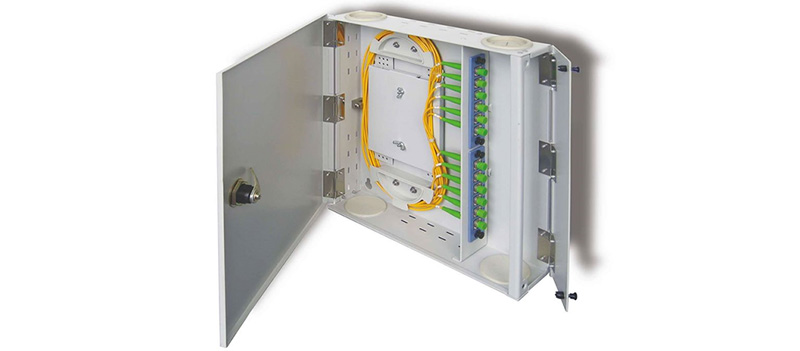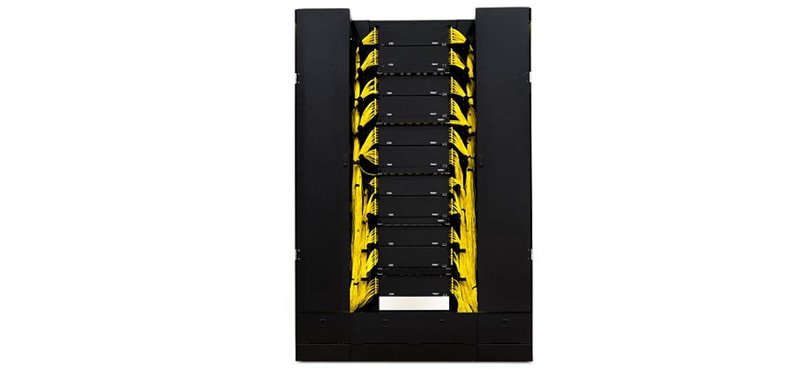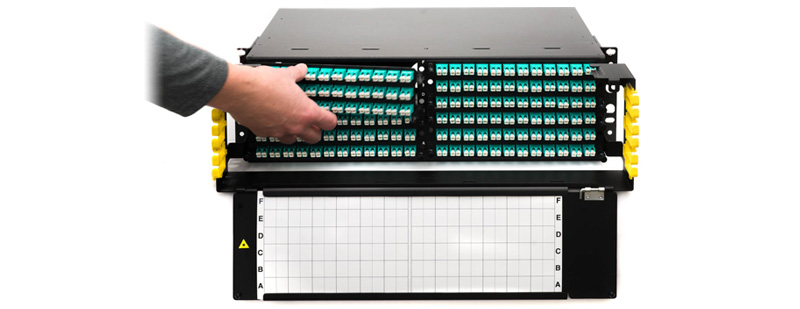What is Optical Distribution Frame (ODF)?

Managing fiber cables in a complex FFTx network can be a big job. Therefore many network managers will install ODF to organize fibers from various terminals in the optical distribution network (ODN). What is ODF in telecoms? What is the optical distribution frame? How To choose ODF types for current and futureproof requirements? This article is an optical distribution frame wiki to answer those questions and more.
What is Optical Distribution Frame (ODF)?
Optical Distribution Frame or Fiber Distribution Frame is the full name of ODF / FDF. In telecommunications, an Optical Distribution Frame (ODF) is a crucial infrastructure device used to terminate and distribute optical fiber cables within a network.
More specifically, it is mainly used for fiber fusion splicing of the optical cable terminal, the installation of optical connectors, the deployment of optical paths, the storage of excess pigtails, and the protection of optical fibers. Hence, it integrates key functions such as fiber splicing, termination, routing, and storage into a single unit for streamlined management.The fiber distribution frame is of significance for the safe operation and flexible deployment of the optical fiber networks.
ODF vs ODN Optical Distribution Network Explained
ODN meaning in telecom is one of the basic technologies or components for composing a passive optical network (PON) in FTTx applications. In a typical PON system, data transmission begins at the optical line terminal (OLT) and ends at the Optical Network Terminal (ONT) / Optical Network Unit (ONU), during which ODN network functions as a physical channel between the two.
ODF is one of the products that compose the ODN optical distribution network. Other components are fiber optic cable, optical splitter, optical distribution cabinet (ODC, FDH), fiber distribution box (FDB), optical connector, optical joint closure (FOC), terminal box (FTB), and etc.
ODF Types, Structures, Functions & Usage
Breakdown by structure or mounting type, three major optical fiber distribution frames are rack-mount ODF, wall-mount ODF, and cabinet-mount ODF.
ODF Wall Mount
The wall-mount optical distribution frame is generally a box structure, inner containing a distribution panel. A closed ODF wall mount is often hung with a lock.
Wall-mounted ODFs are ideal for direct installation on wall at places with a small number of optical cables and optical cores. As for applying outside, an outdoor ODF box can resist harm from rain, sunshine, dust, and etc.

Fig 1: Wall mount ODF with box shell fixed on the wall can be shaded and rainproof.
ODF Rack Mount
Rack-mount optical distribution frames generally adopt a modular design. It can be a pre-assembled one with loaded fiber optic adapters or an unloaded open one. For the latter, users can choose corresponding modular cassettes or adapters according to the number and specifications of optical cables, and flexibly assemble them on the rack.
Most rack mount optical distribution frame is installed in a 19" rack. It is a future-oriented structure that can provide convenient conditions for the future development of optical fiber distribution frames.

Fig 2: 19" rack-mount ODF preloaded with LC duplex connectors or adapters.
ODF Cabinet
The cabinet optical distribution frame adopts a closed structure, with a lockable front door and side panels.
Cabinet optical distribution frame is available with different types, ranging from open frame cabinets for custom installation, basic configured cabinet ODF, or a loaded cabinet with a full set of assemblies such as doors, fiber patch panels, slides, modular cassettes, etc.
An assembled cabinet is placed in the server room. Looks beautiful and neat as the picture shows.

Fig 3: a cabinet ODF
Mini ODF
Mini ODF can be regarded as a wall mount ODF mini version. It looks quite identical to a regular wall-mounted ODF. The difference lies in fiber capacity. Generally speaking, a mini wall mount optical distribution frame is available up to 48 fiber cable capacity.
High-Density ODF Rackmount
Increasing demand for bandwidth has pushed more fiber cables deployment, especially at the access layer. Network managers are under great pressure to increase optical density. For they have to consider both the manageability and adaptability of fiber optic cabling and cost-efficiency. High-density ODF with an open design provides a flexible and scalable solution for even the most complex FTTX networks. High-density ODFs maximize space efficiency by accommodating more fiber connections per unit of rack space, making them ideal for data centers and telecom hubs with growing bandwidth needs.

Fig 4: A high-density optical distribution frame with open architecture leaves space for future connection growth, allowing custom your termination needs.
Hybrid Distribution Frame
With the increasing degree of network integration, the high-density optical distribution frame appears one after another. Say, an optical-digital hybrid distribution frame integrates ODF, DDF (Digital Distribution Frame), and PDU (power distribution unit) in a single unit. It is ideal for SMB distribution frames of fiber wires to the cell, building, remote module, and wireless base station.
The optical distribution frame is mostly made of aluminum, which has a firm structure and beautiful appearance. The external dimensions should be consistent with the standard rack of the current transmission equipment to facilitate the installation and arrangement of the machine room. In addition, for computer rooms that require cleanliness, the appearance color should be considered similar to the overall tone of the computer room.
Noted: In the market, finished ODF telecom products with different structures may have different names, such as fiber distribution frame, ODF fiber box, or fiber ODF panel. QSFPTEK can provide you with a range of ODF and ODN products, please feel free to contact us.
A Brief ODF Selection Guide
In optical fiber network construction, ODF selection is an essential subject. Besides knowledge of structure type, a professional network manager should take other factors into consideration, such as installation place, fiber capacity, functions, installation flexibility, and user-friendliness. The following part will focus on three factors that the author thinks are the most important.
Installation Place
Fixed on the wall or mounted on the rack is the foremost question you should think about. The typical rack size is 1U 19". Some vendors may also provide ODF of rack space 2U, 3U, 4U, or more. Then, choose one with the corresponding mounting type and rack space.
Fiber Count Capacity
The basic requirement is — the optical fiber distribution frame should be able to house the optical fiber cable with the maximum number of cores in the front-end equipment room completely. One can find ODF 12 core, 24 core, 48 core in the market. For high-density deployment such as telecommunication networks, FTTH, ODF with 96 core, 144 core, 192 core may be a better choice. For assembled ODF, be mind to check the fiber adapter type in the optical distribution frame specification.
Function
Consider possible functions such as fiber termination, fiber fixation, thread adjustment, optical fiber core protection, logo record, and optical storage.
Summary
The optical distribution frame is a supporting device to terminate and distribute fiber cables in the ODN network. ODF types include ODF rack-mount, ODF wall-mount, and cabinet ODF cabinet, etc. Remember to consider critical factors such as installation environment, fiber capacity, and functions when making a choice. Keep an eye on our latter updates to learn what's the difference between optical distribution frame vs patch panel.
If you have any questions on the ODF frame or need quotations for related products such as fiber optic cables, please contact us via [email protected]. Our sales experts have 10 years of experience in optical communications and have a deep understanding of industry products.











